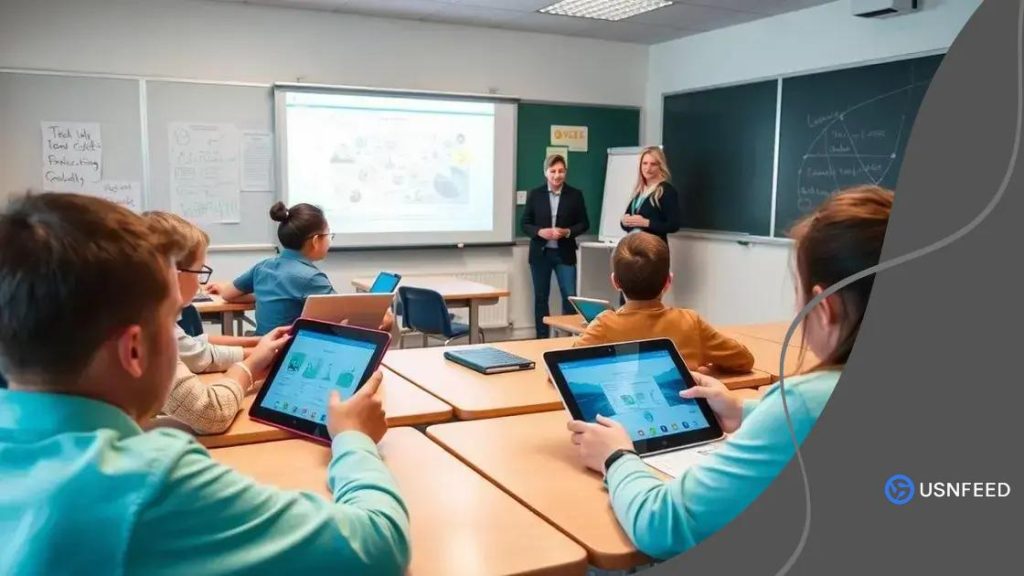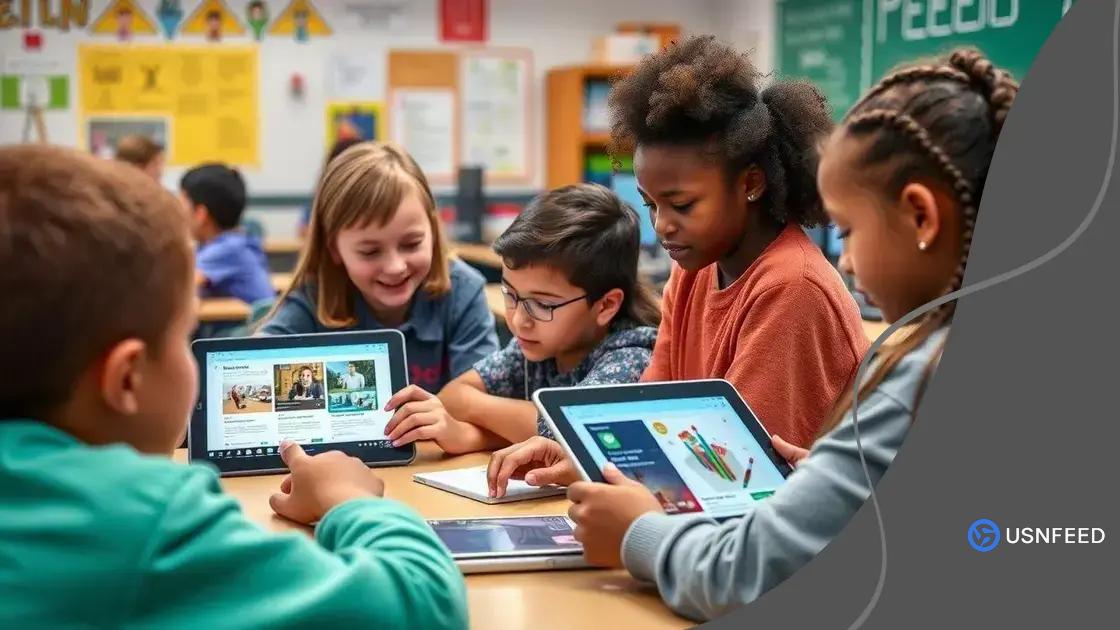The role of technology in the classroom is changing learning

The role of technology in the classroom enhances learning by increasing engagement, personalizing education, and providing diverse resources while addressing challenges such as cost and training needs.
The role of technology in the classroom has transformed how students learn and engage. Have you ever wondered how tablets and smartboards shape today’s educational landscape? Let’s dive deeper into this topic.
Enhancing engagement through interactive tools
One of the most significant benefits of technology in the classroom is its ability to enhance engagement. Interactive tools can turn learning into an exciting experience. By utilizing these resources, teachers make lessons more dynamic and enjoyable for students.
Types of Interactive Tools
There are numerous tools available that educators can incorporate into their teaching. These tools not only capture attention but also help in retaining information. Some popular interactive tools include:
- Smartboards: These allow teachers to display lessons interactively, where students can participate directly.
- Educational Apps: Apps designed for various subjects can make learning fun and tailored to individual needs.
- Polling Software: This enables real-time feedback during lessons, making it easy to gauge student understanding.
- Video Conferencing: Tools like Zoom allow for virtual classrooms, promoting interaction even from home.
Interactive tools encourage collaboration among peers. When students work together, they learn not just from the teacher, but also from each other. This teamwork fosters a better understanding of subjects. Teachers can monitor progress through these tools, helping them adjust teaching methods based on student response.
Moreover, utilizing technology in lessons helps prepare students for the modern world. Digital literacy has become essential in various fields, and incorporating these tools in education will cultivate important skills. Schools that focus on interactive learning will likely see a rise in student motivation.
The benefits of online learning platforms
Online learning platforms have become essential in today’s educational landscape. They offer flexibility and accessibility, making learning possible anytime and anywhere. This shift allows students to tailor their education to their own schedules and needs.
Key Benefits of Online Learning Platforms
These platforms provide a range of advantages that enhance the learning experience:
- Flexibility: Students can learn at their own pace, enabling them to revisit complex topics whenever necessary.
- Accessibility: Online resources are available to anyone with an internet connection, breaking geographic barriers in education.
- Diverse Learning Materials: These platforms often include videos, quizzes, and interactive content that cater to different learning styles.
- Cost-Effectiveness: Many online courses are more affordable than traditional education, reducing financial barriers for students.
In addition to these benefits, online learning fosters self-discipline and time management skills. Students learn to set their own goals and deadlines, enhancing their responsibility for their education. Furthermore, the ability to interact with peers through forums or discussion boards creates a sense of community, even in a virtual space.
Online platforms often allow for personalized learning paths. Educators can track progress and tailor content to meet individual student needs. This way, students receive targeted support, helping them succeed academically. As technology advances, the potential of online learning continues to grow.
Using technology for personalized education

Using technology for personalized education transforms how students learn and grow. These tools can tailor the learning experience to fit individual needs, making education more effective and engaging.
Benefits of Personalized Education
By utilizing technology, educators can offer a customized learning path for every student. Some key benefits include:
- Adaptable Learning Experiences: Software can adjust difficulty levels based on student performance, ensuring they are challenged yet capable of succeeding.
- Targeted Support: Technology can identify areas where students struggle and provide additional resources to help them improve.
- Variety of Learning Materials: From videos to interactive lessons, technology provides diverse resources that cater to different learning styles.
- Increased Engagement: Personalized learning often leads to higher student interest and participation in lessons.
Furthermore, technology encourages autonomy in students. They can take charge of their education by choosing which topics to explore, creating a more meaningful learning experience. This empowerment enhances their motivation and confidence. Tools such as learning management systems (LMS) allow teachers to track progress easily, adjusting lesson plans based on real-time data.
Virtual platforms also facilitate collaboration between students. They can work on projects together, sharing their insights and learning from one another. This collaborative aspect not only enriches the educational experience but also helps develop essential social skills.
Challenges of technology integration in classrooms
Integrating technology into classrooms presents several challenges that educators must navigate. While it offers great potential, there are issues that can hinder its effectiveness.
Common Challenges of Technology Integration
Here are some key challenges teachers and schools face:
- Training and Support: Many educators feel unprepared to use new technologies. Ongoing training and support are essential for successful integration.
- Cost of Implementation: Investing in technology can be expensive. Schools must allocate budget for devices, software, and maintenance.
- Access to Resources: Not all students have equal access to technology at home, leading to disparities in learning experiences.
- Technical Issues: Internet connectivity and software problems can disrupt lessons and frustrate both students and teachers.
In addition, curriculum alignment can be a hurdle. Teachers need to ensure technology used in the classroom supports the learning objectives. Sometimes, the tools may not fit seamlessly into the existing curriculum, causing additional stress in planning lessons.
Another significant challenge is student distraction. While technology can enhance learning, it also offers opportunities for students to get sidetracked. Teachers must implement strategies to keep students focused on their work.
Finally, the rapid pace of technological change means that educators need to be adaptable. New tools continuously emerge, requiring teachers to stay up-to-date and often rethink their approaches to teaching.
Future trends in educational technology
The world of educational technology is constantly evolving. Future trends are shaping the way students learn and teachers instruct, creating exciting possibilities for the classroom.
Emerging Trends in Educational Technology
Several trends are expected to gain momentum in the coming years:
- Artificial Intelligence: AI can personalize learning experiences by adapting content to fit individual student needs, making education more effective.
- Virtual and Augmented Reality: These technologies can provide immersive learning experiences, allowing students to explore concepts in 3D environments, such as historical events or scientific phenomena.
- Gamification: Incorporating game elements into learning can boost student engagement and motivation, making complex subjects more enjoyable and relatable.
- Adaptive Learning Technologies: These systems assess student performance in real-time, adjusting the difficulty of tasks based on their understanding and progress.
In addition, schools will increasingly adopt cloud-based solutions. This shift will enhance collaboration and access to resources for both teachers and students. Cloud platforms enable easy sharing of materials and foster communication among students, regardless of location.
Mobile learning is also on the rise. Students can learn on-the-go using their smartphones, making education more flexible and accessible. This is vital for accommodating diverse learning styles and schedules.
Importantly, as technology advances, educators will need to focus on digital literacy. Teaching students how to navigate digital tools responsibly and effectively will be essential for their success in a technology-driven world.
FAQ – Frequently Asked Questions about Technology in Education
What are the main benefits of using technology in the classroom?
Technology helps engage students, personalizes learning experiences, and provides access to diverse educational resources.
What challenges do teachers face when integrating technology?
Common challenges include the cost of technology, need for training, and ensuring equal access for all students.
How can future trends in technology affect education?
Emerging trends like AI and virtual reality will create more personalized and immersive learning experiences for students.
Why is digital literacy important for students?
Digital literacy equips students with the skills to navigate technology responsibly and effectively, preparing them for a tech-driven world.